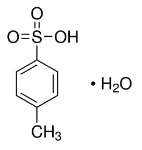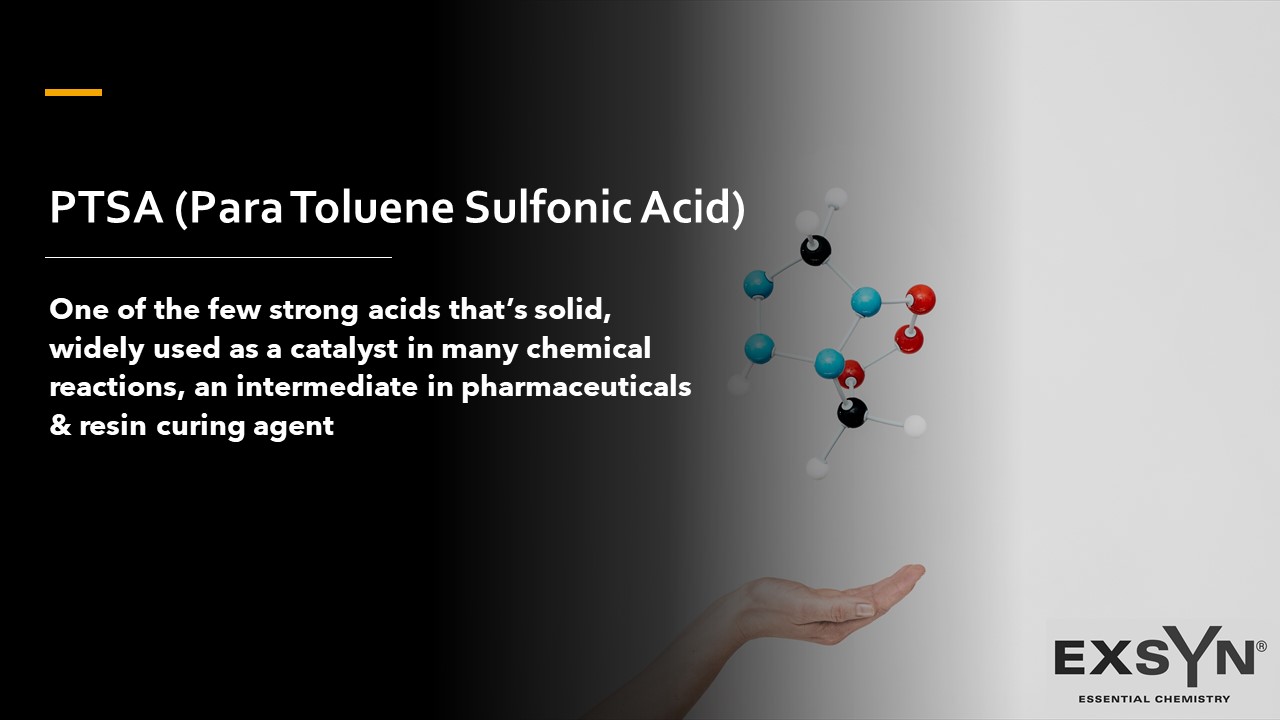INTRODUCTION
PTSA or pTsOH or Tosylic acid (TsOH) is white solid organic compound, that is soluble in water, alcohols, and other polar organic solvents. The group is known as the tosyl group and is often abbreviated as Ts or Tos.
TsOH is about one million times stronger than benzoic acid. It is one of the few strong acids that is solid and hence conveniently weighed. It is available both in crystalline form as well as a solution and has a wide range of applications.
| Synonyms | 4-Methylbenzenesulfonic acid Tosic acid, Tosylic acid PTSA |
| CAS no. | 6192-52-5 (monohydrate) 104-15-4 (hydrous / solution) |
| EINECS no. | 203-180-0 |
| Molecular formula | C7H8SO3.H2O |
| Molecular weight | 190.22 |
| Structure |  |
APPLICATIONS
PTSA is widely used as a catalyst and as an intermediate in a variety of applications such as:
| A catalyst in the synthesis of pharmaceuticals, pesticides, polymerization stabilizer, paint intermediates, cross linking reactions and resin curing agent. It is also a commonly used acid catalyst in organic synthesis. |
| As an intermediate in fine chemicals, dyestuffs & pigments. |
| As a curing agent in thermosetting resin systems, varnishes, acrylic resins, etc. |
| As a hydrotropic coupling agent & a wetting agent in esterification / condensation / acetylation / polymerization / alkylation / hydrolysis / dehydration. |
| It is comparable in strength to mineral acids such as sulphuric acid but is especially suitable for organic reactions where an inorganic, mineral acid could cause charring, oxidation or an unwanted chemical reaction. |
SPECIFICATIONS
| Test | Unit | Specification |
|---|---|---|
| Appearance* | – | White crystalline powder |
| Assay on Monohydrate basis | % | Min 98 |
| P-isomer content in the active Material by a) HPLC method b) Others | % – | Min 92 Balance |
| Free Sulphuric Acid | % | Max 0.3 |
| Iron Content | ppm | Max 10.0 |
| Total Moisture | % | Max 11.50 |
| Melting Point | °C | Min 99 |
| Solubility in water | – | 100% soluble, clear solution |
*Note: The international specification of PTSA is white to off white to pink, though the material supplied would be white. However, as the product is highly hygroscopic – due to heat, sunlight and moisture the color may change from white to off white or pinkish in the course of time.
SPECIFICATIONS of 65% solution
| Test | Unit | Specification |
|---|---|---|
| Appearance | – | Pale yellow to amber colored liquid |
| Assay (on Anhydrous basis) | % | Min 65.0 |
| Free Sulphuric acid | % | Max 1.0 |
| Specific gravity (at 25°C) | – | 1.22 ± 0.02 |
REACH status
PTSA offered by ExSyn is registered under EU REACH regulation.
STORAGE
The product is stored at ambient temperature.
ExSyn can offer PTSA grades as low as 0.1% free sulfuric acid, resulting in lower corrosion of user’s equipment and can also offer customized specifications if needed.
No matter the quantity you need, our exceptional quality and service will make ExSyn your supplier of choice! If you need any additional information or SDS, please get in touch with us.
5-Methyl-3-vinyl-2-oxazolidinone (V-MOX) is a highly reactive monomer valued for its low viscosity, mild odor, and excellent reactivity. It is widely used as a reactive diluent in UV-curable inks and coatings, where it enhances adhesion, produces brighter colors, and improves safety compared to conventional diluents. In addition, V-MOX serves as a key building block in the synthesis of kinetic hydrate inhibitor (KHI) polymers, which are applied in oil and gas production to prevent hydrate blockages in pipelines.
Zinc ricinoleate is the zinc salt of ricinoleic acid, a hydroxylated fatty acid derived mainly from castor oil (Ricinus communis). It appears as a white to slightly yellowish powder, waxy solid, or paste, depending on formulation. Its most valuable property is its ability to trap and absorb odor molecules such as amines, sulfides, and short-chain fatty acids, making it an essential ingredient in deodorant and odor-control products.
2-(tert-Butyl amino)ethyl methacrylate (TBAEMA) is a functional methacrylate monomer that contains a secondary amine group and a hydrophobic tert-butyl moiety, giving it excellent versatility in pH-responsive and adhesion-enhancing polymer systems.
It is valued in printing ink formulations for its ability to enhance adhesion, flexibility, and surface interaction.
Commonly known as potassium bis(fluorosulfonyl)imide (KFSI), the compound has a three-carbon backbone bearing six fluorine atoms and two sulfonimide (-SO₂F) groups. The molecule’s architecture lends it both high chemical stability and useful reactivity. Because of its excellent ionic conductivity and thermal / electrochemical stability, it finds use in advanced electrolyte formulations—for example in lithium-ion and next-generation batteries, in ionic liquids, and in other electrochemical systems.
Colchicine is a naturally occurring alkaloid obtained primarily from the autumn crocus (Colchicum autumnale) and related species. It has been used in medicine for centuries, especially for the treatment of gout and Familial Mediterranean Fever. In modern medicine, Colchicine is valued also in conditions like pericarditis, Behçet’s disease, and certain dermatological and cardiac disorders.
1-Butylimidazole is a versatile organic heterocyclic compound belonging to the imidazole family, where a butyl group (–CH₂–CH₂–CH₂–CH₃) is attached to the nitrogen atom at the 1-position of the imidazole ring. Its applications span organic synthesis, materials science, and bioactive compound development due to its tunable physicochemical properties and structural versatility.
Atropine sulfate monohydrate is a chemical compound, specifically a salt of atropine and sulfuric acid, with one water molecule (monohydrate) attached. It is commonly used as a medication and in research due to its anticholinergic properties, meaning it blocks the effects of acetylcholine at muscarinic receptors.
4-Aminobenzoic acid, commonly abbreviated as PABA, is an aromatic amine and carboxylic acid compound. It consists of a benzene ring substituted with an amino group (–NH₂) in the para position to a carboxylic acid group (–COOH).
2-Amino-5-Nitrophenol (5-NAP) is an organic compound with the molecular formula C₆H₆N₂O₃. It is a substituted phenol with both an amino group (-NH₂) and a nitro group (-NO₂) attached to a benzene ring, along with a hydroxyl group (-OH).
